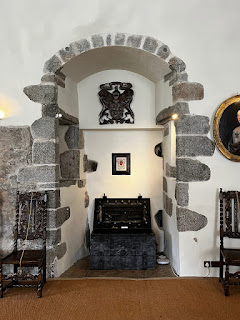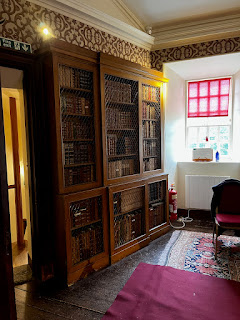I was surprised to see the pink color in the distance. This was now the 3rd castle of similar design and color, which is a lovely rosy pink. I had no idea that there were several with the same notable color and features. Upon entrance to the castle, we learned that the tour was self guided, but there were two particular guides who were extremely enthusiastic in offering explanations.
History tells us that the land was granted by James II to Thomas Fraser in 1454 at which time he built a 3 story rectangular tower house, which continues to be the core of the castle today.
The former main hall, holds a representation of the castle, and the guide gave us a detailed explanation of who added what when.
In 1570, Laird Michael Fraser began to upgrade and expand to make it a livable residence.
The main hall that we entered maintained the look of the original keep.
At this time, the castle was known as Muchill-in-Mar Castle.
Michael Fraser passed, and his son Andrew, named the 1st Laird Fraser by Charles I, completed the project his father had begun in 1618. The dining room was added as an extension in 1633.
The table that stands there is original to the house.
The carved doorway is believed to be from the 1600s and original to the castle as well.
In addition, there is a small room that appears to have been a chapel, also dating back to the 1600's.
There was a priest hide in the floor, as well as this obvious peep hole that allowed one to peer into the grand hall, the first room where we entered.
In 1644, the castle came under attack, but, luckily, it was left unscathed.
As is often the case, the castle changed hands passing through a spinster named Elyza Fraser in 1695 to Charles Mackenzie Fraser's son, Alexander Mackenzie Fraser.
He had served as an officer in the Duke of Wellington's army during the Napoleonic wars. He and his wife made some significant changes to the castle, adding extra wings for a more comfortable space.
Their son, Charles Mackenzie Fraser inherited the house.
He was married to Jane Hey.

The guide in the library was quite excited to share the story of Charles regarding his battle scars.
Charles had been Captain in the Coldstream Guards. When he was getting dressed for battle, he realized that his hat was falling over his eyes. There was really no explanation for that happening, but he decided to fold up a silk handkerchief, and shove it under the rim to keep his hat from falling over his eyes.
During the battle, a bullet whirled towards his head, landing right in the middle of the silk handkerchief. Apparently the silk was hard enough when folded, to stop a bullet from entering his head, and it was credited for saving Charles' life.
A few months later, in 1812, he lost a leg at the Battle of Burgos due to a bullet entering his calf. His injury resulted in his return to Castle Fraser, where he subsequently retired from the Guards. But, he did not let his injury keep him from living a relatively normal life. When the National Trust received the castle, they found 20 different wooden legs used by Charles, stored in a closet. There is a case along the wall that holds the musket ball that injured him in battle.
In 1830, Charles combined two separate bedrooms into one, where he established a library, music and game room. The shelves hold more than 2600 books and a large collection of sheet music as well as a piano and violin on display.
It seems that Charles and Jane both enjoyed playing the piano together.
The oldest item in the library is this clock, made in London, dated 1735.
While winding up the stairs in the turret, we were able to enter various rooms, all with unique names. The Peacock Room has an unusual painting of Charles I. It is painted on Glass, sometime in the 1800's and is a copy of the Van Dyke painting, but this one was painted in China.
Charles and Jane had fourteen children, several who died as children. Their son, Frederick, inherited the castle. He was first married to Blanche Drummond. In a room just off the library, this painting of Blanche hangs on the wall. Note the curtains on either side.
It appears that Blanche died from tuberculosis just a few years after her marriage, and Frederick had the painting made posthumously.
Sometime shortly thereafter, he married a woman named Theodora. It is said that when Frederick would leave the castle, Theodora would draw the curtains closed over the painting until his return. Personally, I would have just stayed out of the room. It's not like the place isn't big enough to go elsewhere!
Continuing our rounds up the turret, we ended up outside on the balcony with easy access to a roof view.
It is quite obvious that the estate is very large, as only one building could be spied, and that was more than likely the stables for the castle.
Back inside, and down the stairs, there were several rooms with interesting items. I spotted this small painting of one of the governesses on the estate. She was in house from 1828-1830.
I thought her painting fit her role perfectly!
In a separate room, there was quite a collection of specialized ceramics.
All really quite entertaining.
When Frederick passed, the castle went to his wife, Theodora. But he left no money in order for her to live. She sold several original Raeburn paintings, and had them replaced with copies, so that she would have funds to live.
In 1921, Theodora was impoverished, and sold the castle to Weetman Pearson, known as Viscount Cowdray, in order to have funds for herself. Pearson had made a fortune as a civil engineer, and from what we were told, he apparently liked to "collect" castles. His son, Clive Pearson, was given the castle, and he restored it to its previous glory before gifting it to his daughter, Lavinia and her husband, Major Michael Smiley. In 1976, the couple sold the castle to the National Trust.
As you can see, the tour of the castle was really quite interesting, but I do feel compelled to make a comment here. I noted a group of women touring the castle, and overheard them discussing that this was the same Fraser who is featured in the Starz series, Outlander. Then, I heard her add, "although some of it is fiction."
Although some of the names in the Fraser family are featured in the series, this particular castle was never used for filming. And even though this family had strong Jacobite ties, and many of the clan were killed during the battle of Culloden, the main character in the series does not exist in this family. But, don't let me burst your bubble.
If it gets them funding for improvements to the property, then why not?
The grounds of the castle feature a lovely walled garden.
As you can see, some of the flowers continue to be vibrant with blooms.
And there were some chairs for relaxing, if one was so inclined.
Dinner was in a restaurant in Ellon, just a few miles away from where we are staying.
I'll admit, it was a huge disappointment. But, considering that the two previous nights meals were outstanding, I'm not complaining. I could probably use a bit of a cutback at this point!
We then returned to our B&B called Outlander Boutique B&B.... and no....there is NO connection to the series Outlander. And no sign of a Fraser in sight!
Hope you enjoyed today's adventure!
Until next time...





































